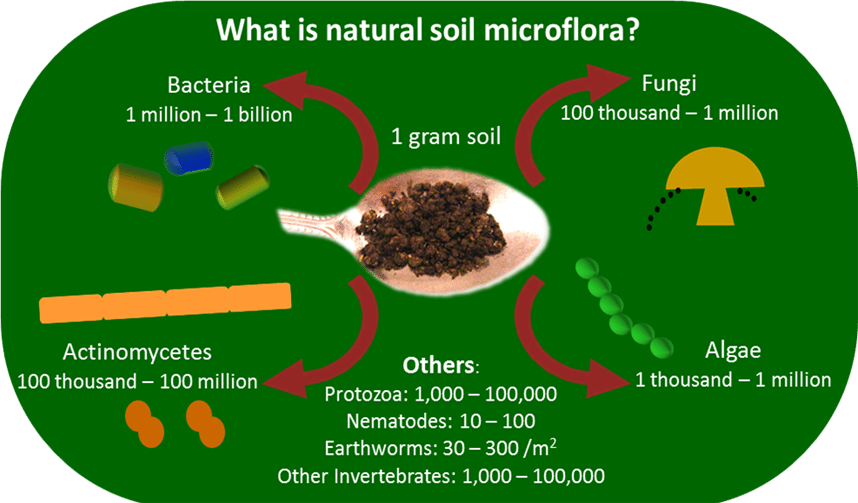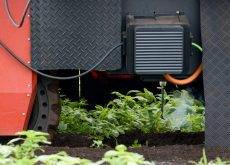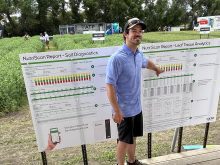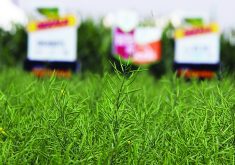Biological partners | Inoculants co-operate with natural soil microflora instead of competing for supremacy
Two new liquid rhizobial inoculants, the first of their kind to be registered in Canada, are available for soybeans, peas and lentils.
Developed by the Winnipeg bioresearch company XiteBio Technologies, these inoculants differ from conventional products in the way they form co-operative, synergetic partnerships with background rhizobia that have inhabited the soil for millions of years.
As prairie growers continue to expand soybean acreage, they turn to growth stimulants such as the new inoculant called XiteBio SoyRhizo. This product increases soybean yield by three to nine bushels in documented field trials in Saskatchewan, Manitoba and the United States, according to the company.
Read Also

Canada told trade crisis solutions in its hands
Canadians and Canadian exporters need to accept that the old rules of trade are over, and open access to the U.S. market may also be over, says the chief financial correspondent for CTV News.
The inoculant for peas and lentils is called XiteBio PeasRhizo, and it increases pea yield by an average of 2.2 bu. per acre in similar documented field trials, said Manas Banerjee, president of XiteBio.
“These nitrogen fixing rhizobium should work 85 to 90 percent of the time,” said Banerjee, adding that he is confident in his numbers because the products have been registered and used in the States since 2011.
However, the inoculants didn’t officially receive Canadian registration until May 31, 2013.
The delay in paperwork meant the registration came too late for this year’s crop.
SoyRhizo and PeasRhizo represent a new approach to soil biology called advanced growth promoting technology (AGPT), according to Banerjee.
“Nobody else has this technology. It’s exclusive to XiteBio,” said Banerjee, adding that his challenge has been to develop biological inoculants that don’t fight with Mother Nature’s many soil borne agents.
He said any kind of biological agent we introduce into a teaspoon of soil is, by its nature, foreign to that soil. It either has to out compete and dominate the background biologicals already in the soil, or it loses out to those natural organisms.
The third option is to introduce new organisms that can co-operate with the indigenous ones.
“Take one teaspoon of soil. That’s one gram of soil. It has literally billions of natural biological residents.
“There are fungi, bacteria, algae, actinomycetes, protozoa, nematodes, earthworms and many other invertebrates. It’s a very hostile environment for any foreign biological agent.”
Banerjee has an example to explain how introduced biologicals cope in a soil environment where they are not welcome.
“For example, if somebody wants the president’s chair, there are two ways he can go about it. He can try to kick the president out, but if that president is very strong, you have no chance. He will win.
“It’s the same thing in soil. If you add something and the background microflora is stronger, then you lose the value of your inoculants. Your foreign biological inoculants will not become established.”
Banerjee said conventional competitive biological inoculants technology does not have a high success rate.
He says XiteBio instead focuses on AGPT rhizobium that will function alongside the natural background biologicals most of the time.
“That’s the second way to approach the president’s chair. How about if I go to make a friendship with the guy in the powerful chair? We make a handshake and I say ‘Can you make your chair just a little bit bigger.’
“That’s the way my XiteBio rhizobium works in the soil. Rather than fighting with the natural biological background, we try to find agents that get along well in the soil.
“We call it invigorating the natural microflora. We don’t force the new biological product on the existing natural system. We work with the existing microflora.”
The heart of SoyRhizo is an ancient nitrogen fixing bacterium called Bradyrhizobium japonicum. Combined with the AGPT process, this bacterium increases nodulation which leads to stronger soybean plants with higher yields.
Banerjee said PeasRhizo is the sister to SoyRhizo, using the same basic concept but with the natural agent Rhizobium leguminosarum, which is naturally suited to peas and lentils. It also enhances nodulation, which in turn maximizes pea and lentil yield.
Both XiteBio products have proven to be successful in the Illinois, Indiana, Iowa regions and through the Canadian prairie provinces.
The biological background of soil changes significantly throughout the vast tract of land, going south to north, as well as east to west.
How can scientists develop commercial rhizobium products that are effective through such a wide range of soil types and climate conditions?
“We aren’t trying to invigorate every type of microflora in the soil, only the ones we need to interact with the soybean roots or the pea and lentil roots. Those are the rhizobia we’re looking for,” Banerjee said.
When asked if either product can save crops under extreme stress, Banerjee was blunt, saying that the rhizobia require oxygen and moisture to survive and to enhance nodulation.
“In a flooded field, there’s no benefit at all because the oxygen is cut off. The bacteria die.
“In drought conditions, there might be a small benefit if the rain comes soon enough, because the plant is healthier. But the bacteria must have moisture, so I would have to say that any benefit you see would not be significant.”
Acidity is another factor that negates the benefits of the rhizobium. Banerjee said potential customers should save their money if their soil pH is in the range of 5.0 to 5.5.
“There are no rhizobium products that work well in those acid situations. For our products, we’re looking for normal soil situations with the soil pH around 6.5 or better.
“Rhizobium bacteria can work in acidic soils if the farmer limes it up to 6.5. But the number has to be high enough so bacteria can survive and thrive and colonize the soil.”
Banerjee said his products are user friendly.
“It’s all in one package. There’s no need to mix powder and water. Just open the package and use it. As long as it doesn’t freeze or bake, it should work for you 85 to 90 percent of the time.”
For more information, contact Manas Banerjee at 204-257-0775 or visit www.xitebio.ca.


















